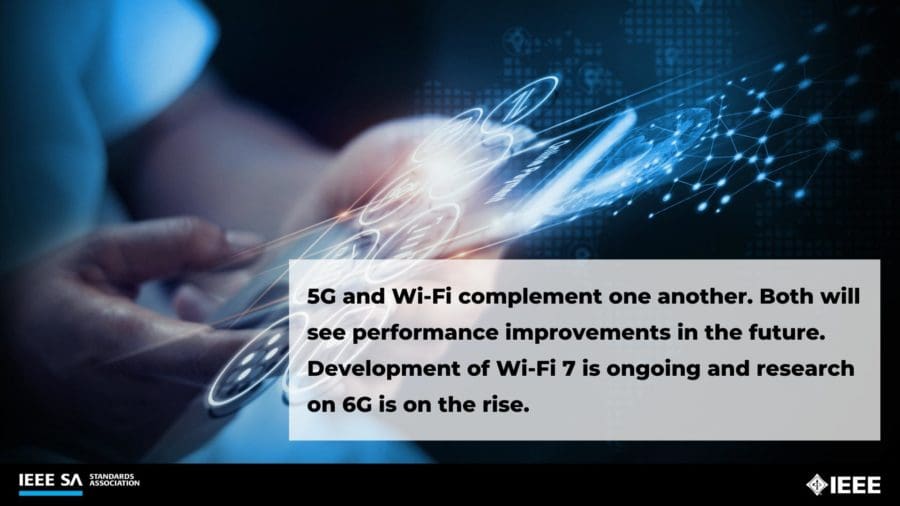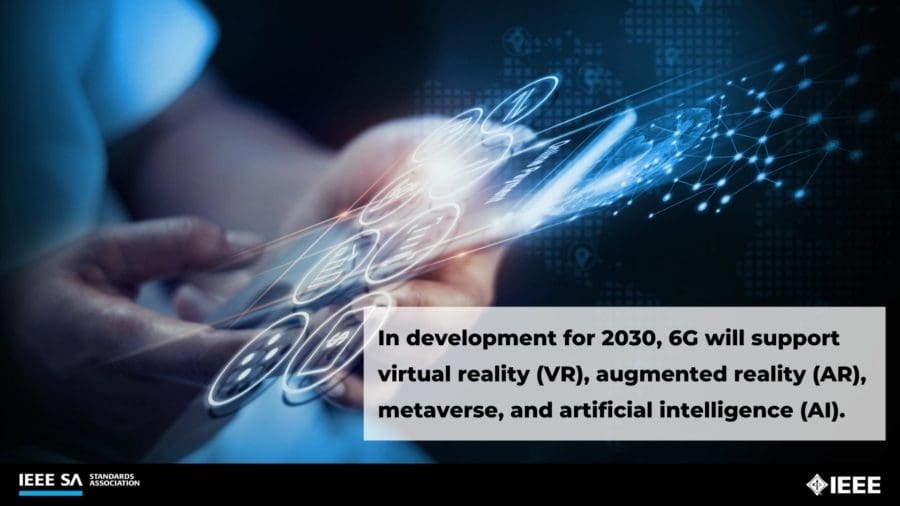Highlights:
- Research and development around 6G are on the rise. 6G will significantly improve download speeds, eliminate latency, and reduce congestion on mobile networks.
- In development for 2030, 6G will support advancements in technology, such as virtual reality (VR), augmented reality (AR), metaverse, and artificial intelligence (AI).
- The industry is in need of standardized frameworks, guidelines, and solutions to deliver optimal user experiences to consumers, IEEE SA is working to support the development of 6G technology on multiple fronts.
Technological advances are growing exponentially. New capabilities make everyday tasks easier or in some cases completely eliminate old ways of doing things.
We’re at the beginning of the rollout of 5G, offering greater speed and capacity than ever before. From smart homes and telehealth to immersive games, new and emerging features powered by 5G have elevated our experiences.
While we have yet to experience the full potential of 5G technology, we’re already hearing murmurs of 6G technology. What is 6G, when is 6G coming, and how will it impact us?
What is “G”?
“G” refers to “Generation”. 1G was introduced in 1979 in Tokyo. This first generation of wireless cellular technology was born and by 1984, the entire country of Japan had 1G. 1G was approved in the United States in 1983 with Canada and the United Kingdom following a few years later.
How Do Cell Phones Work?
All wireless devices like cell phones and tablets are connected to phone and Internet services by radio waves through an antenna in a cell tower. Carriers pay to use this “cell” along with others in a geographical area. These successive cells create a spectrum band so users stay connected when moving from one cell to another.
Carriers rely on subscription fees to cover the costs of creating these cell networks whether they are building, maintaining, and upgrading the towers or leasing the bands.
The Path to 5G: How Did Cellular Technology Evolve?
1G facilitated the introduction of the mobile phone to consumers. However, because of the exorbitant cost, it was mostly used by business executives and seen as a status symbol. It was time to make the product and service affordable for greater consumption and address cellular technology inefficiencies. With 1G analog mobile communications standards:
- Coverage was poor.
- Sound quality was subpar.
- There was no compatibility between systems or providers.
- Because an analog wave comes through exactly as it is created, calls between people could be overheard via radio scanners, making for a lack of privacy.
- Maximum speed was 2.4 Kbps.
2G was created on a digital cellular network standard. Because digital converts analog to numbers, 2G offered encrypted calling with better sound quality, text messaging, and picture or multimedia file messages. Enabling these alternative communication types was possible because 2G offered a theoretical maximum transfer speed of 40 Kbps. 2G saw larger-scale construction of cell towers and considerable buy-in from the public as phones and service plans became more affordable.
Demand for better accessibility drove the creation of 3G in 2001. It brought global interoperability. Now, users could access data anywhere in the world via greater web connectivity. Its faster speed added new communications options like video conferencing, streaming, and voice over IP (VoIP). 3G standards were required to provide peak data rates of at least 144 Kbps with a maximum of 14 Mbps.
Now that human-to-human communication was settled, it was time to tackle the need to handle large quantities of data. Reduced latency, the amount of time that information takes to travel from its source to its destination, and then come back to its source, is a major benefit of 4G.
4G offered faster web access and added cloud, gaming, High Definition (HD) videos, and 3D TV to the growing list of amenities devices that it could handle. 4G standards set minimum requirements at 10 Mbps and peak speed at 100 Mbps. However, the quicker data exchange and new features made it necessary to purchase 4G-enabled devices.
Even 4G was not going to be fast enough to advance technology and accommodate the potential of the Internet of Things (IoT) to control thermostats, connected vehicles, smart cities, and more or enable healthcare possibilities with wearables, telehealth, image transfer, and more.
The 5G technology standard for broadband cellular networks to provide connectivity for cellphones began deploying worldwide in 2019. 5G technology increased bandwidth, the capacity on the radio spectrum, to connect more devices in an area and boasts eventual download speeds of 10 Gbps. 5G can operate in 3 frequencies, including low-band (600-900 MHz with download speeds of 30-250 Mbps), mid-band (1.7-4.7 GHz with download speeds of 100-900 Mbps), or, the new addition, high-band millimeter wave (mmW) (24-47 GHz with download speeds of Gbps).
5G vs. Wi-Fi: How are They Related?
Wi-Fi is a local area network (LAN) and cellular networks like 5G are wide area networks (WAN). Wi-Fi was developed about 30 years ago.
Wi-Fi is based on the IEEE 802.11 family of standards where 802.11ac is for Wi-Fi 5 and 802.11ax is for Wi-Fi 6, also referred to as High-Efficiency WLAN. These rely on an unlicensed spectrum that is free to use but has a relatively weak signal. An internet service provider (ISP) delivers Internet to our house and the router fills our house with Wi-Fi. The two frequencies that Wi-Fi uses are 2.4 GHz with lower top speed but longer range and 5 GHz which can deliver faster speeds but doesn’t penetrate walls easily.
Most of us rely on a Wi-Fi network at home, in the office, or in coffee shops and cellular networks when we move out of range of a router. 5G and Wi-Fi complement one another. Phones and Internet-connected devices automatically switch between the two to provide a good connection at all times.
Both cellular networks and Wi-Fi will see performance improvements in the future. Development of Wi-Fi 7 is ongoing and IEEE P802.11be can bring enhancements for Extremely High Throughput (EHT) which will provide device manufacturers with design specifications to govern interoperability and performance. For cellular networks, research and development around 6G are on the rise.

What is 6G?
The 6G technology standard for cellular networks will still most likely still be broadband – data transmission over a wide band of frequencies. The service area will most likely remain divided into cells. 6G will continue where 5G left off by improving download speeds, eliminating latency, reducing congestion on mobile networks, and supporting advancements in technology.
Frequencies from 100 GHz to 3 THz are promising bands for the next generation of wireless communication systems because of the wide swaths of unused and unexplored spectrum, according to a paper published on IEEE.
These upgrades bring about new quests. Phones that can accommodate 6G will need to be developed. Connectivity needs to be delivered more efficiently and effectively to more devices. Burgeoning technologies like smart cities, interconnected cars, wearable devices, and robots will need to share bandwidth. This could mean building more cellular networks or finding new ways to deliver millimeter waves.
We’ll begin to experience and envision the potential of 6G with 5G-Advanced in 2024, which will further increase data transfer speeds. 5G-Advanced will enable immersive technologies like AR, VR, and mixed reality (MR) will open new opportunities for how we conduct business, run factories, and protect the environment.
When is 6G Coming?
6G holds the promise to transform how the human, physical, and digital worlds interact. In development for 2030, 6G will likely support virtual reality (VR), augmented reality (AR), metaverse, and artificial intelligence (AI).
How we experience everyday life and operate within it will dramatically change based on the enhanced information that will be able to be delivered to us in real-time from sensors, AI, machine learning (ML), and digital twins.

How Will 6G Improve Communications?
- Because 6G will be able to provide even more data transfer from IoT, we can be more productive at work and at home.
- Phones may be further developed into our keys and money.
- Typing may be replaced with voice or movement.
- Implanted sensors, telesurgery, and wearables could transform healthcare.
- Holographic meetings might succeed online conference calls.
- Connected vehicles will have the ability to intercede a car crash.
- Network signals can sense where we are, what is around us, and when combined with AI, ML, and digital twinning, will be able to provide radio frequency (RF) sensing.
- 6G may finally deliver worldwide connectivity by reaching remote locations currently with no Internet access via satellites that may reduce the need to construct cell towers.
How Will 6G Boost Interoperability?
6G could go beyond our current network of cell towers to include new connectivity methods. Backward compatible with current and earlier “G”s and embracing these new ways to connect, 6G can optimize connectivity thereby enabling greater data transfer. This faster data exchange can open up many new possibilities for:
- Interoperability between humans, earth, space, and sea via sensing.
- Human communication with robots, IoT devices, and wearables.
- Robots performing dangerous jobs in place of humans, for example, in mines, and transmitting data easily.
- Education being further reaching and more immersive.
- Robots and drones to supplement the hospital and delivery service industries.
- Radio frequency sensing of where devices are to offer new cybersecurity options.
How Will 6G Affect the Environment and Sustainability?
- IoT will control appliances and reduce electricity usage as well as contribute to optimization for automated manufacturing, connected vehicles, drone agriculture, and more.
- 6G would enable smart transportation where connected electric vehicles, cameras, and roads communicate to optimize traffic flow.
- Connected machines and robots will more efficiently manage supply chains to reduce energy and water usage and carbon emissions.
- Smart agriculture can use sensors to control water, monitor livestock, and provide accurate pesticide use to reduce carbon emissions.
- 6G could assist with the move to renewable energy and smart grids could optimize energy distribution.
- The 6G network will be more efficient than 5G and consume less power. Through digitization, 6G can power future applications and help to achieve energy efficiency.
How is IEEE SA Enabling the Launch of 6G and Future Networks?
The promise of 6G technology is drawing the attention of many industry stakeholders to play a part in the research, development, and application of 6G. While 6G will likely impact virtually every area of our lives and open up new opportunities for businesses, the industry is in great need of standardized frameworks, guidelines, and solutions to deliver optimal user experiences to consumers.
IEEE Standards Association (IEEE SA) brings together experts in telecommunications and connectivity to support the development of 6G technology on multiple fronts, including open RAN, cybersecurity, and building a transdisciplinary communications framework across industries. Learn more about how IEEE SA is contributing to 6G and future networks.

